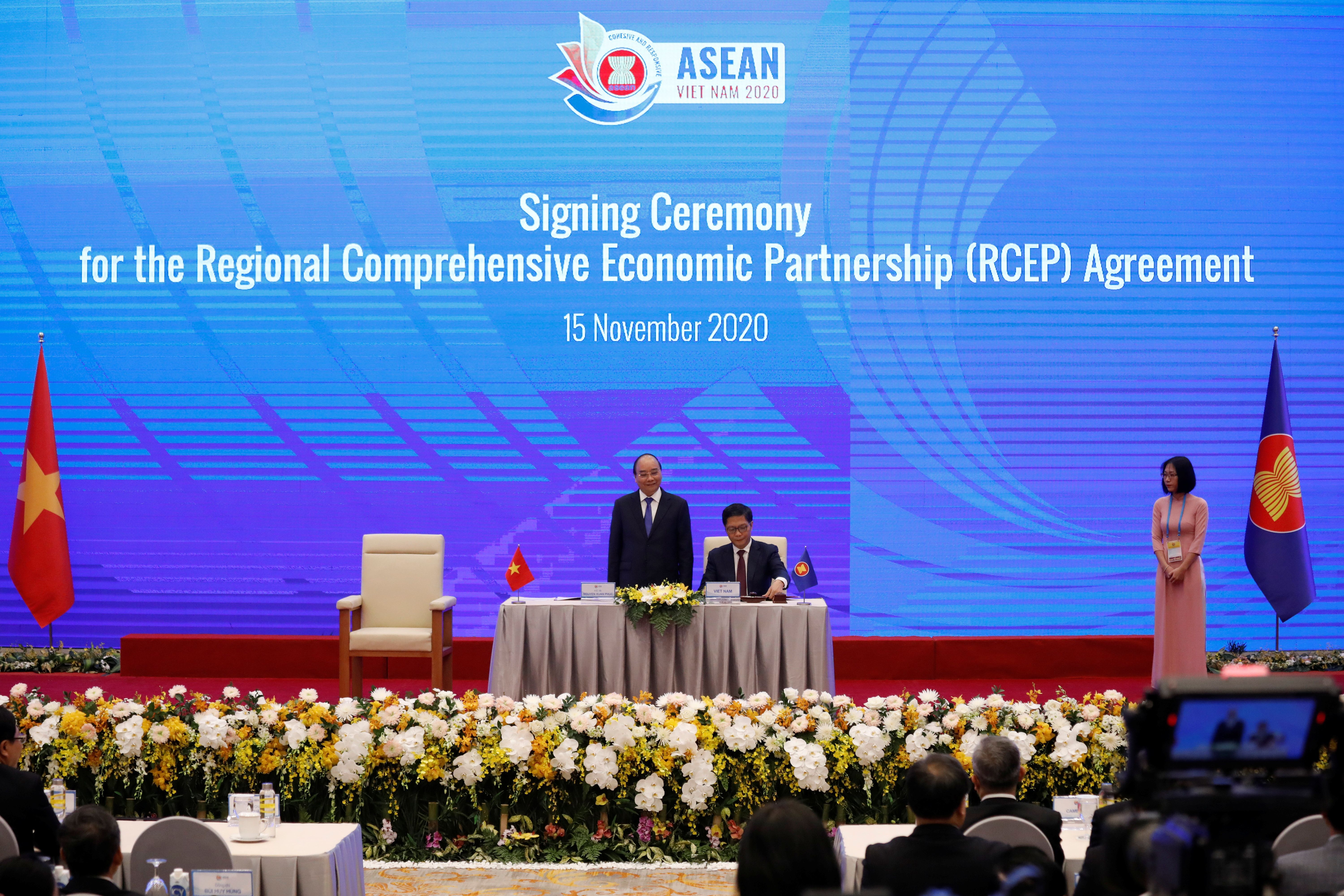Signing of the RCEP, the World’s Largest Free Trade Agreement

Under what circumstances was the agreement signed?
The RCEP was signed—online—as part of the 37th ASEAN summit in Hanoi. In 2012, ASEAN initiated negotiations with 16 countries: its 10 members plus six partners with which it already had trade agreements—China, India, Japan, South Korea, Australia, and New Zealand. The purpose of the agreement is to improve economic cooperation, in part by complementing existing free trade agreements between the members, such as those concerning rules of origin which facilitate supply chains. The decision to sign the RCEP was also influenced by trade disturbances caused by the U.S.-China dispute and the COVID-19 pandemic. Although India participated in the negotiations from the beginning, it withdrew in November 2019, chiefly over what it regarded as insufficient protection in the deal against the inflow of goods, especially from China.
What is included in the RCEP?
The agreement provides for the elimination of duties on around 90% of tariff lines within 20 years. It also introduces common regulations in areas such as competition, services, technical standards, e-commerce, intellectual property, and investment. However, the RCEP has limited provisions on agriculture, and excludes a number of sensitive products from trade liberalisation (e.g., rice in the case of Japan). The agreement also does not provide for common standards in labour rights or environmental protection. This makes it less ambitious than the CPTPP agreement signed in 2018, which also eliminates more customs duties—on as much as 99% of product groups. The assumption is that the RCEP is a framework for further negotiations on important trade issues.
What is the impact of the agreement on the situation in Asia-Pacific?
The RCEP is the next example, after the CPTPP, of the intensifying integration in Asia-Pacific in recent years (seven countries are signatories of both agreements). It should not only increase trade but also the flow of investments and thus strengthen regional supply chains. This may support the post-pandemic economic recovery of the members of the agreement. Thanks to the RCEP, China will be able to further tighten economic relations with the countries of the region, including U.S. allies Japan and South Korea, with whom China is still negotiating a joint trade agreement. These three countries may also be the biggest beneficiaries under the RCEP. With this deal, China is increasing its political influence at the expense of the U.S. The signing of the RCEP also indicates a growing role for ASEAN in integrating and stabilising the region.
What does the conclusion of the agreement mean for the EU?
The entry into force of the agreement may reduce the competitiveness of EU companies on the markets of RCEP countries, especially those with which the Union has not signed a free trade agreement. Thus, part of the EU’s trade with the signatory states will be replaced by trade between RCEP members. This situation may induce the EU to intensify talks on trade agreements with such countries as Australia, New Zealand, and ASEAN members with whom the EU does not have similar agreements (e.g., Indonesia, the Philippines), and in the future, also with the entire Association. The main incentive for these countries will be access to the large and absorbent EU market. Strengthening regional cooperation also creates opportunities for European companies that invest in RCEP countries to gain easier access to other markets covered by the agreement.
What does the conclusion of the deal mean for the U.S.?
RCEP will also make American companies less competitive on the markets of its member states. The U.S., which is neither a member of the RCEP nor the CPTPP, also now has less influence on trade rules in the Asia-Pacific region. Thus, its political influence is weaker at the same time China’s is increasing. To strengthen the U.S. position in the region, the incoming Biden administration may consider joining the CPTPP. The U.S. had been a party to the negotiations of this agreement (when it was still just TPP) during the Obama administration, in which Joe Biden was vice-president. The U.S. under Donald Trump withdrew from the deal at the beginning of his term in 2017. This scenario, however, does not seem realistic for the time being because of protectionist sentiment in the U.S., including in the Democratic Party, and Biden has stated that negotiations on trade agreements will be suspended until the U.S. economy strengthens after the pandemic.
What is the significance of the agreement for the global economy?
RCEP will be the largest free trade area in the world—its members account for around 30% of global GDP and population. The agreement is an expression by the countries of the region, whose economies are strongly based on exports, to curb protectionism in world trade, which was exacerbated by the pandemic. Increased trade under the RCEP framework could also stimulate production and demand for services in third countries, which would have a positive impact on the global economy. According to The Peterson Institute for International Economics, the deal could boost global GDP by $186 billion annually by 2030. However, the failure to include in the agreement rules on, for example, environmental issues and labour rights, will limit its impact on shaping global trade rules.


